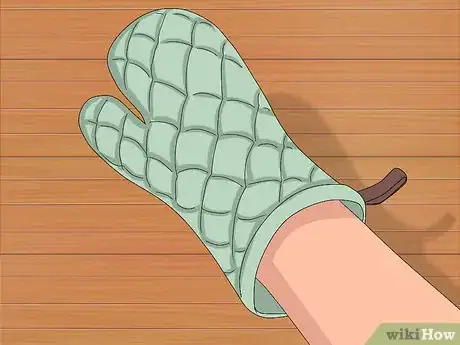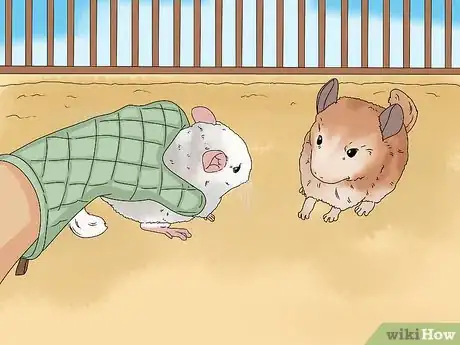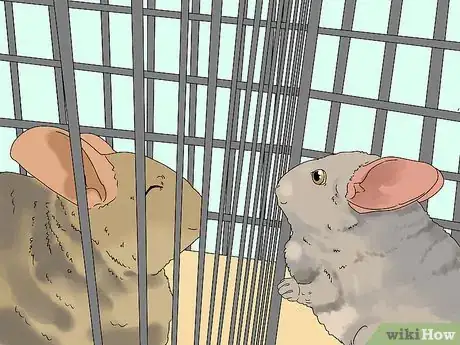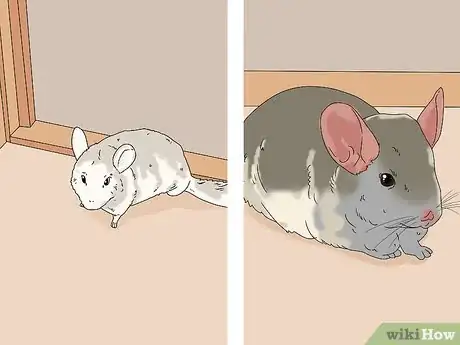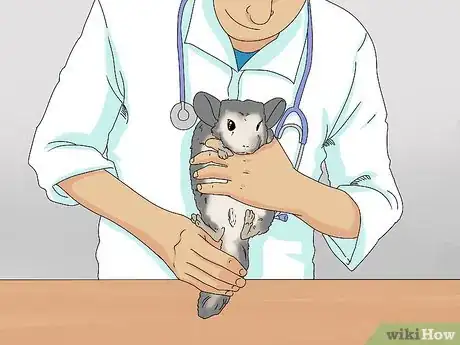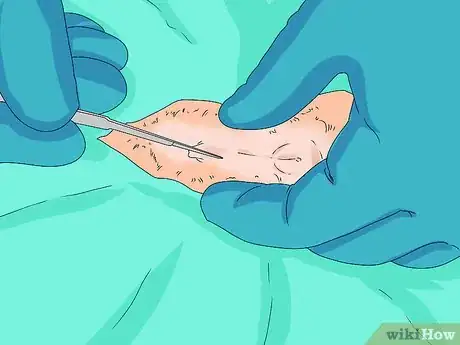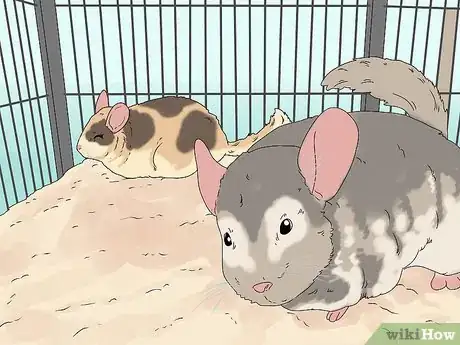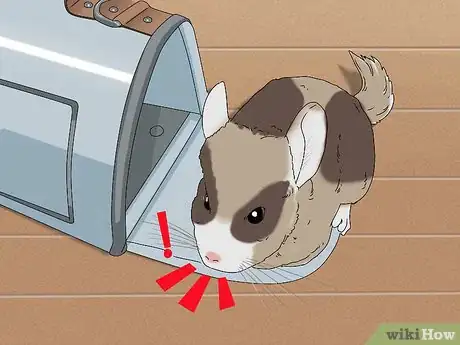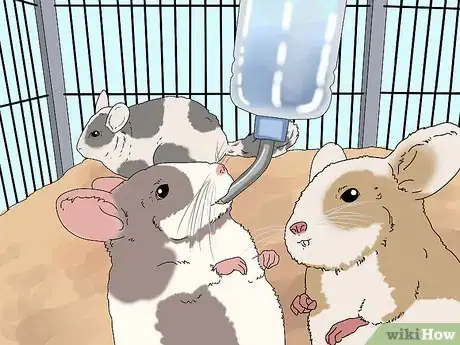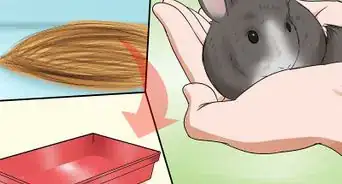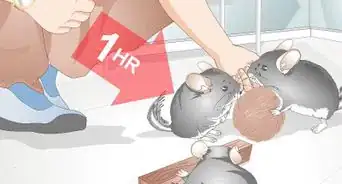This article was co-authored by Natalie Punt, DVM. Dr. Natalie Punt is a Veterinarian and the Founder and CEO of mPet- a smart phone app for pet owners to store, manage and transfer their pets medical records and health information. She specializes in small animal emergency and general medicine and veterinary practice economics. Dr. Punt holds a BS in Biochemistry and Molecular Biology from The University of California, Davis, an MS in Biochemistry from The University at Buffalo, and a DVM from Western University of Health Sciences.
There are 10 references cited in this article, which can be found at the bottom of the page.
This article has been viewed 13,991 times.
Chinchillas are adorable pets but they can also be very territorial. While chins don’t need to be social to be happy, there may come a time when you want to have playdates with other chins or introduce a new chin into your family. As a chinchilla owner, not only must you know how to stop a fight between chinchillas, you should know how to prevent it from happening again.
Steps
Stopping the Attack
-
1Wear an oven mitt when pulling the chinchillas apart. The thick material will protect your hands from being bitten or scratched by teeth or claws in the midst of the fight.[1]
-
2Pick up one of the chinchillas by supporting their whole body. Grabbing a chinchilla up by their tail can hurt them. Instead, firmly hold the base of their tail to keep them still and lift their entire body at once.[2]Advertisement
-
3Separate the 2 chinchillas immediately. Chinchilla fights are fast and furious and can last for mere seconds. Because chins have sharp teeth and nails, these fights can unfortunately result in very serious injuries or even death.[3] Make sure you wear something to protect your hands. If you don't have an oven mitt, thick rubber gloves will work.
- Always stay in the room where you can see both chins and get to them quickly should an issue arise. Letting them out of your sight for just a couple of minutes could be extremely dangerous.
- Because of the quick nature of chinchilla fights, you shouldn't put two unfamiliar chins together in a confined space like a cage. Instead, keep them in an open area where one could escape if being attacked.[4]
-
4Cover 1 chinchilla in a blanket or towel. Think of this as a time-out. Blocking them from the sight of the other chinchilla can calm them down enough (or at least momentarily surprise them) for you to remove the other chin from the room without injury.[5]
- You may also be able to distract your chinchilla with raisins, one of their favorite treats.[6]
-
5Put them in separate rooms to let them cool down. If your chinchilla is overly agitated, simply putting space between them and the other chin might not be enough to reduce stress.[7] Even just the scent of the other chinchilla can induce anger so return each chin to their cages in different rooms.[8]
- If no blood was drawn, the two chinchillas could still become friends. Give them time to recover in their separate rooms, then reintroduce them to each other in a couple of days if you're comfortable.
-
6Take your chinchilla to the vet if there's an injury. If your chinchilla was bitten or if you notice blood, contact your vet immediately. Even what looks like a minor scratch could become infected if not taken care of properly so have a vet check it out.
- Chinchillas are not often biters, so if your chinchilla was the one who did the biting, you should also consult your vet. That kind of behavior could be a sign of a more serious health issue.[9]
Preventing a Future Fight
-
1Get male chinchillas neutered. To reduce aggression in a male chin, take him to your vet to be castrated.[10] This will especially help if you want to introduce a female into your household.
-
2Keep chinchillas in separate cages.[11] While individual living spaces will prevent any physical fights, you can keep the cages side by side to help your chins get acclimated to each other. Sometimes it just takes them getting used to the smell of the other chin over the course of a few weeks to feel more comfortable.
- Leave about 2 to 3 inches (5.1 to 7.6 cm) in between the cages so that the chinchillas can't scratch or bite each other.
-
3Pair an older chinchilla with a younger one. This combination tends to be the most successful at living together.[12] Same-sex cage mates can also happily share a space. However, avoid putting two male chinchillas together if there’s a female nearby as they will most likely fight to show dominance and win over the female for breeding.[13] [14]
- If you do have 2 chinchillas in a cage together, make sure the cage is big enough. Overcrowding is one of the biggest triggers for fighting between chins. The minimum cage size for a pair of chinchillas is about 3.5 by 5 by 4 feet (1.1 by 1.5 by 1.2 m).[15]
-
4Listen for barking noises or angry calls. How do you know if chinchillas are fighting or just playing? Barking from one or both chins usually means that they are unhappy with one another. Consider this a signal to take them away from each other.[16]
- A chinchilla has 4 different calls they use when feeling defensive or angry.[17] The next time you notice your chinchilla is in one of these moods, listen closely to the noises they’re making so you can identify them.
- High-pitched squeals are often emitted when the chin is frightened or in pain.
-
5Accept that your chinchilla might not want to socialize with others. While chinchillas live in colonies in the wild, they can get enough social interaction as pets from quality time spent with you, their owner.[18] Your chinchilla doesn't need a rodent companion to be happy.[19]
- Frequent interaction with humans can reinforce positive behavior towards other chinchillas. Play with your chinchilla during the evening hours when they're most alert and energetic since they are nocturnal creatures.
Expert Q&A
-
QuestionCan chinchillas be kept together?
 Natalie Punt, DVMDr. Natalie Punt is a Veterinarian and the Founder and CEO of mPet- a smart phone app for pet owners to store, manage and transfer their pets medical records and health information. She specializes in small animal emergency and general medicine and veterinary practice economics. Dr. Punt holds a BS in Biochemistry and Molecular Biology from The University of California, Davis, an MS in Biochemistry from The University at Buffalo, and a DVM from Western University of Health Sciences.
Natalie Punt, DVMDr. Natalie Punt is a Veterinarian and the Founder and CEO of mPet- a smart phone app for pet owners to store, manage and transfer their pets medical records and health information. She specializes in small animal emergency and general medicine and veterinary practice economics. Dr. Punt holds a BS in Biochemistry and Molecular Biology from The University of California, Davis, an MS in Biochemistry from The University at Buffalo, and a DVM from Western University of Health Sciences.
Veterinarian They can, but make sure you have a really big cage—this way, they can comfortably distance themselves from one another.
They can, but make sure you have a really big cage—this way, they can comfortably distance themselves from one another. -
QuestionHow should I set up my chinchilla cage?
 Natalie Punt, DVMDr. Natalie Punt is a Veterinarian and the Founder and CEO of mPet- a smart phone app for pet owners to store, manage and transfer their pets medical records and health information. She specializes in small animal emergency and general medicine and veterinary practice economics. Dr. Punt holds a BS in Biochemistry and Molecular Biology from The University of California, Davis, an MS in Biochemistry from The University at Buffalo, and a DVM from Western University of Health Sciences.
Natalie Punt, DVMDr. Natalie Punt is a Veterinarian and the Founder and CEO of mPet- a smart phone app for pet owners to store, manage and transfer their pets medical records and health information. She specializes in small animal emergency and general medicine and veterinary practice economics. Dr. Punt holds a BS in Biochemistry and Molecular Biology from The University of California, Davis, an MS in Biochemistry from The University at Buffalo, and a DVM from Western University of Health Sciences.
Veterinarian Place little pieces of enrichment in the cage, like different types of substrates or platforms. This way, the chinchillas can hide, get away, or jump away from another animal that's trying to be more dominant or aggressive.
Place little pieces of enrichment in the cage, like different types of substrates or platforms. This way, the chinchillas can hide, get away, or jump away from another animal that's trying to be more dominant or aggressive. -
QuestionI have 3 chinchillas, 1 girl 2 boys. 1 boy and the girl keep on fighting do you know how to stop it because the boy is younger and hes gotten really scared of her.
 CalypsoTwistCommunity AnswerThe boy may be fighting because he wants to show sexual dominance to the girl. If he is younger, he may want to mate with her but may not be old enough to. Keep the chinchillas apart until they get older, so they won't fight again. I suggest getting the girl spayed or both of the boys neutered so you won't have any problems in the future.
CalypsoTwistCommunity AnswerThe boy may be fighting because he wants to show sexual dominance to the girl. If he is younger, he may want to mate with her but may not be old enough to. Keep the chinchillas apart until they get older, so they won't fight again. I suggest getting the girl spayed or both of the boys neutered so you won't have any problems in the future.
References
- ↑ https://www.chinchillarescue.org/introducing.html
- ↑ https://www.bluecross.org.uk/pet-advice/caring-your-chinchilla
- ↑ https://www.chinchillarescue.org/introducing.html
- ↑ http://www.chincare.com/HealthLifestyle/IntroductionsDynamics.htm
- ↑ https://petponder.com/mixing-chins-techniques-for-introducing-two-or-more-chinchillas
- ↑ https://www.bluecross.org.uk/pet-advice/caring-your-chinchilla
- ↑ https://www.petcha.com/when-chinchillas-attack/
- ↑ https://letslovechinchillas.weebly.com/bonding-chinchillas.html
- ↑ http://www.pets.ca/exotic/articles/chinchilla-behavior-problems/
- ↑ https://www.rvc.ac.uk/Media/Default/Beaumont%20Sainsbury%20Animal%20Hospital/documents/caring-for-your-chinchilla.pdf
- ↑ Natalie Punt, DVM. Veterinarian. Expert Interview. 19 August 2021.
- ↑ https://petponder.com/mixing-chins-techniques-for-introducing-two-or-more-chinchillas
- ↑ https://letslovechinchillas.weebly.com/bonding-chinchillas.html
- ↑ Natalie Punt, DVM. Veterinarian. Expert Interview. 19 August 2021.
- ↑ https://www.bluecross.org.uk/pet-advice/caring-your-chinchilla
- ↑ https://squeaksandnibbles.com/can-chinchillas-live-alone/
- ↑ https://squeaksandnibbles.com/can-chinchillas-live-alone/
- ↑ https://letslovechinchillas.weebly.com/bonding-chinchillas.html
- ↑ Natalie Punt, DVM. Veterinarian. Expert Interview. 19 August 2021.
